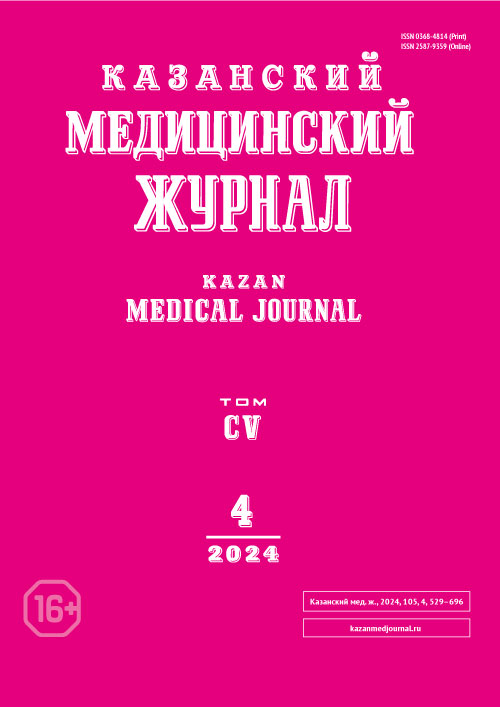Results of surgical treatment of adrenocortical cancer
- Authors: Kotelnikova L.P.1,2, Fedachuk A.2
-
Affiliations:
- Perm State Medical University named after E.A. Wagner
- Perm Regional Clinical Hospital
- Issue: Vol 105, No 4 (2024)
- Pages: 560-566
- Section: Theoretical and clinical medicine
- Submitted: 12.04.2024
- Accepted: 26.06.2024
- Published: 25.07.2024
- URL: https://kazanmedjournal.ru/kazanmedj/article/view/630263
- DOI: https://doi.org/10.17816/KMJ630263
- ID: 630263
Cite item
Abstract
BACKGROUND: Adrenalectomy is the only possible method of radical treatment of adrenocortical cancer, and surgical approach (laparotomy or laparoscopy) remains a subject of debate.
AIM: To evaluate one-year mortality in patients with adrenocortical cancer and determine its relationship with age, stage of the disease, tumor characteristics according to computed tomography results, and surgical approach.
MATERIAL AND METHODS: In the Perm Regional Clinical Hospital, over the past 7 years, 107 patients have been operated on for adrenal tumors, of which 15 (14.01%) people were diagnosed with adrenocortical cancer. Adrenalectomy was performed by open (11) and laparoscopic (4) approaches. The results were assessed by the number of local relapses of the disease and life expectancy. Statistical analysis was carried out using standard application programs Statistica for Windows 10.0. Nonparametric methods of descriptive statistics were used. To determine the relationship between individual pairs of characteristics and the degree of its severity, the Spearman correlation coefficient (r) was calculated.
RESULTS: Stage I of the disease according to the ENSAT classification was found in 1 case, II — in 7, III — in 5, IV — in 2 cases. The size of tumors removed laparoscopically was significantly smaller (p=0.042) compared to those operated on with an open approach. One-year survival rate was 80%. Surgical approach and combined operations did not affect one-year mortality (r=0.277; p=0.298 and r=–0.462; p=0.071). A relationship was found between lethal outcomes and age (r=–0.539; p=0.030), and the rate of washout of the contrast agent from the tumor in the delayed phase when performing computed tomography (r=–0.845; p=0.034). In case of lethal outcomes, the rate of washout of the contrast agent was the lowest. The life expectancy of patients depended on the stage of the disease (r=–0.590; p=0.016).
CONCLUSION: One-year mortality in patients with adrenocortical cancer was 20% and had a moderate positive correlation with age, stage of the disease and a strong correlation with tumor characteristics based on bolus-enhanced computed tomography, but had no relationship with the chosen surgical approach.
Keywords
Full Text
About the authors
Liudmila P. Kotelnikova
Perm State Medical University named after E.A. Wagner; Perm Regional Clinical Hospital
Author for correspondence.
Email: splaksin@mail.ru
ORCID iD: 0000-0002-8602-1405
MD, Dr. Sci. (Med.), Prof., Head of Depart., Depart. of Surgery with the Course of Cardiovascular Surgery and Invasive Therapy
Russian Federation, Perm; PermAlexey Fedachuk
Perm Regional Clinical Hospital
Email: 89024747460@mail.ru
ORCID iD: 0000-0001-5756-8981
MD, Cand. Sci. (Med.), Doctor, Surgical Depart. No. 2
Russian Federation, PermReferences
- Filimonyuk FV, Kharchenko NV, Leonov BI, Smirnova EA, Antonov AK, Smelkova NI. Immediate and long-term results of surgical adrenocortical cancer treatment. Vestnik novykh meditsinskikh tekhnologii. Elektronnoe izdanie. 2013;(1):68. (In Russ.) EDN: RSTUDH
- Britvin TA, Krivoshein AV. Long-term results of surgical treatment for adrenocortical cancer. Almanac of Clinical Medicine. 2016;44(5):631–634. (In Russ.) doi: 10.18786/2072-0505-2016-44-5-631-634
- Cavallaro G, Tarallo M, Chiappini A, Crocetti A, Polisrena A, Petramala L, Sibio S, De Toma G, Fiori E, Letizia C. Surgical management of adrenocortical carcinoma: Current highlights. Biomedicines. 2021;9:909–924. doi: 10.3390/biomedicines9080909
- Sinclair TJ, Gillis A, Alobuia WM, Wild H, Kebebew E. Surgery for adrenocortical carcinoma: When and how? Best Pract Res Clin Endocrinol Metab. 2020;34(3):101408. doi: 10.1016/j.beem.2020.101408
- Giordano A, Feroci F, Podda M. Minimally invasive versus open adrenalectomy for adrenocortical carcinoma: The keys surgical factors influencing the outcomes — a collective overview. Langenbecks Arch Surg. 2023;408(1):256. doi: 10.1007/s00423-023-02997-z
- Mpaili E, Moris D, Tsilimigras DI. Laparoscopic versus open adrenalectomy for localized/locally advanced adrenocortical carcinoma (ENSAT 1-111) in adults: Is margin-free resection the key surgical factor that dictates outcome? A review of the literature. J Laparoendosc Adv Surg Tech A. 2018;28(4):408–414. doi: 10.1089/lap.2017.0546
- Melnichenko GA, Stilidi IS, Alekseev BYa, Gorbunova VA, Beltsevich DG, Raikhman AO, Kuznetsov NS, Zhukov NV, Bokhyan VYu. Federal clinical practice guidelines on the diagnostics and treatment of adrenocortical cancer. Problems of Endocrinology. 2014;60(2):51–67. (In Russ.) doi: 10.14341/probl201460251-67
- Mihai R, De Crea C, Guierin C, Torresan F, Agcaoglu O, Simescu R, Walz M. Surgery for advanced malignant disease: Recommendations based on European Society of Endocrine Surgeons consensus meeting. Br J Surg. 2024;111(1):znad266. doi: 10.1093/bjs/znad266
- Kostiainen I, Hakaste L, Kejo P, Parvianen H, Laine T, Loyttyniemi T, Pennanen M, Arola J, Haglund C, Heiskanen I, Schalin-Jantti C. Adrenocortical carcinoma: Presentation and outcome of a contemporary series. Endocrine. 2019;65:166–174. doi: 10.1007/s12020-019-01918-9
- Yashina DP, Afanasyeva ZA, Mazitova FM, Sabirov AG, Zhavoronkov AE. Clinical and pathomorphological “masks” of adrenocortical cancer. Difficulties of differential diagnostics by the example of own clinical observations. Perm Medical Journal. 2023;40(5):147–157. (In Russ.) doi: 10.17816/pmj405147-157
- Rusakov VF, Scherbakov IE, Chinchuk IK, Savelyeva TV, Rebrova DV, Loginova OI, Pridvizhkina TS, Chernikov RA, Krasnov LM, Fedotov YN, Fedorov EA, Sablin IV, Sleptsov IV, Shihmapomedov SS. Diagnostic value in CT examination of patients with adrenal cancer. Problems of Endocrinology. 2022;68(4):13–29. (In Russ.) doi: 10.14341/probl12846
- Kotelnikova LP, Zhizhilev YuV. Computed tomography in the differential diagnosis of adrenal tumors. Endocrine Surgery. 2021;15(4):38–43. (In Russ.) doi: 10.14341/serg12761
- Kiernan CM, Lee JE. Minimally invasive surgery for primary and metastatic adrenal malignancy. Surg Oncol Clin N Am. 2019;28:309–326. doi: 10.1016/j.soc.2018.11.011
- Fassnacht M, Assie G, Baudin E. Adrenocortical carcinomas and malignant phaeochromocytomas: ESMO-EURACAN clinical practice guidelines for diagnosis, treatment and follow-up. Ann Oncol. 2020;31:1476–1490. doi: 10.1016/j.annonc.2020.08.2099
- Gaujoux S, Mihai R, Carnaille B, Dousset B, Fiori C, Porpiglia F, Hellman P, Iacobone M, Kraimps JI, Donatini G. European Society of Endocrine Surgeons (ESES) and European Network for the Study of Adrenal Tumours (ENSAT) recommendations for the surgical management of adrenocortical carcinoma. J Br Surg. 2017;104(4): 358–376. doi: 10.1002/bjs.10414
Supplementary files








